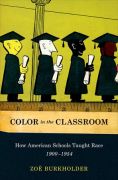
Color in the classroom: how american schools taught race, 1900-1954
Burkholder, Zoe
Color in the Classroom is the first historical analysis of how schools and teachers powerfully influenced the social construction of race in America in the half century before the Brown decision. Color in the Classroom is the first historical analysis of how schools and teachers have powerfully influenced thesocial construction of race in America. Between the turn of the twentieth century and the historic Brown v. Board of Education decision in 1954, the way that American schools taught about "race" changed dramatically. This transformation was engineered by the nation's most prominent activists, including Franz Boas, Ruth Benedict, and Margaret Meadduring World War II. Inspired by scientific racism in Nazi Germany, anthropologists decided that the best way to fight racial prejudice was to teach what they saw as the "truth" about race in the one institution that had the power todo the most good--American schools. Anthropologists created lesson plans, lectures,courses, and pamphlets designed to revise what they called "the 'race' concept" in American education. They believed that if teachers presented race in scientific and egalitarian terms, that American citizens would become less racist. Although nearly forgotten today, this educational reform movement representsan important component of early civil rights activism that emerged alongside the domestic and global tensions of World War II.Drawing on hundreds of first-hand accounts written by teachers nationwide, Zoe Burkholder traces the influence of this anthropological activism on the way that teachers understood, spoke, and taught about race on an everyday basis for more than fifty years. She explains how and why teachers readily translated certain aspects of anthropological theory, such as the division of race into three main categories, while they struggled to make sense of more complex models of cultural diversity andstructural inequality. As they translated anthropological theories about raceinto practice, teachers crafted an educational discourse on race that differed significantly from the definition of race produced by scientists at mid-century. This compelling book will be of special interest to historians ofrace, civil rights, and education, as well as to anthropologists and educators interested in the role of schools as racializing institutions in America. INDICE: Introduction: The Social Construction of Race in American Schools Chapter 1 Race as Nation, 1900-1938 Chapter 2 Franz Boas: Reforming "Race" in American Schools Chapter 3 Ruth Benedict and Margaret Mead: Teaching Teachers Race and Culture Chapter 4 Race as Color, 1939-1945 Chapter 5 Race as Culture,1946-1954 Conclusion Race and Educational Equality after Brown v. Board of Education Notes Bibliography
- ISBN: 978-0-19-975172-3
- Editorial: Oxford University
- Encuadernacion: Cartoné
- Páginas: 272
- Fecha Publicación: 13/10/2011
- Nº Volúmenes: 1
- Idioma: Inglés
